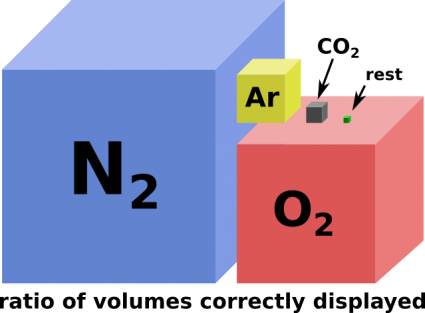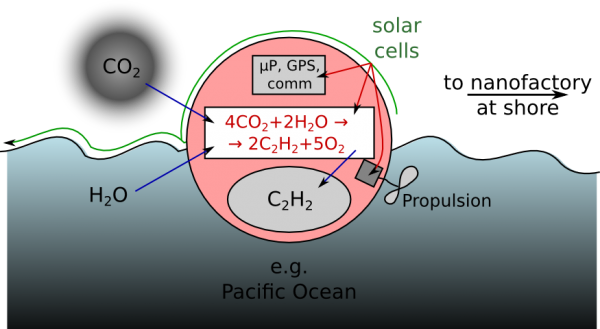Carbon dioxide collector
Template:Questionable article quality
Contents
Good ones and bad ones
Good ones are not self replicating maybe drop the extracted carbon down in form of graphite chips stop carbon extraction at a certain level and care about their fate after their end of service. They have a rather big size that makes handling them easier and may also watch out for bad ones. Bad ones use the extracted carbon solely for self replication and at some point start to produce nasty gasses like Cyanide (HCN) or nitrous gasses (NOx) suddenly and in huge amounts
Both of them may endanger planes and create shadows hampering plant growth.
Locating solar cells for CO2 recuperation sparsely distributed in the air or on the sea instead of placing them concentrated in one place on the ground may be good for environmental (no paveover) and political reasons.
Water
Seaborne air using ships of easy handlable size like mobile energy collector buoys have the potential to fulfill the global energy needs and remove the the excess CO2 that had accumulated due to burning of fossile fuels along with other unwanted gasses of industrial origin.
Swimming units have the benefit of easier access to wind power and easier propulsion. They can easily be kept stationary.
Air
Micro airships:
- have a very lightweight bubble as main body in a size range between 10um and 100.000um
- use depending on size thermal heating or hydrogen for lift
- use their surface for harvesting of solar energy
- are capable of water capture and splitting for compensation of hydrogen diffusion loss
- may be capable of carbon dioxide capture ond splitting
- may be capable of self replication
- may (if malicious) create some nasty gasses
Microscale
Violate spill avoidance guideline (that is keeping microcomponents and the like in macroscopic machine phase blocks) (see waste & recycling)
- Active dust?
- self replicating aerovores (name coined by J. Storrs Hall) - note: potentially misleading bioinspired name (wrongly suggests adaptability)
Questions
To investigate: If replicative how fast could they replicate (doubling time) depending on their diameter?
What is the limiting factor: solar-power for hydrogen generation, diluteness of CO2 or something else?
To investigate: Can they be made to actively propel themselves? Their high volume to mass ratio makes this rather difficult when there's even the slightest bit of wind. Flattening the bubbles drops the aerodynamic resistance significantly.
To investigate: AP manufactured solar cells & mechanosynthetic carbon dioxide splitting
Alternate forms
For swimming ones - micro ships - essentially the same reasoning applies. They need only plain air as lifting medium must be sturdier can use the wind for propulsion and are easier to collect manually (skimming) if something goes wrong.
Extraterrestrial application
(SciFi warning!)
The upper layers of the Venusian atmosphere would be the perfect place for replicative micro airships. There they would provide us with the opportunity of doing an terra-forming or rather terra-changing experiment. If the extracted carbon can be sealed good enough against the frequent and powerful strokes of lightning (questionable) and the extracted carbon can be hold at high altitudes until the lower atmosphere have cooled enough so that the carbon could be put to the ground without reigniting (questionable) then you end up with a cool superdense (too dense for humans) oxygen atmosphere (and a very dangerous situation). Now its the question whether the excess oxygen can be bound into the soil or ridiculous amounts of hydrogen or other abundant reducing elements have to be carried over.
(Even with the complete solar energy hitting Venus directly converted to chemical energy this endeavor would take a very very long time - todo: show the math - also just for removal for sulfuric acid and SO3)
What would a Venus with its over 100 day long day and higher solar constant look like if all the carbon where bound and most of the oxygen where trapped into the soil or water? Would there be lots of poisonous heavy metals around? Would there be any dry land left? How high would the waves get with the extreme winds at the day night borders? What about water vapor clouds, lack of magnetosphere ...? For analysation of those and related questions go to the terraforming Venus page.
Related: Gas giant atmospheres

